Carle Illinois Student-Centered Health Make-A-Thon Addresses Racism as a Health Crisis
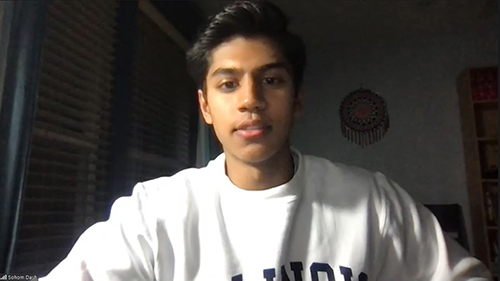
Sohom Dash of Team 6 shares about his team's CrisisVR solution during their presentation.
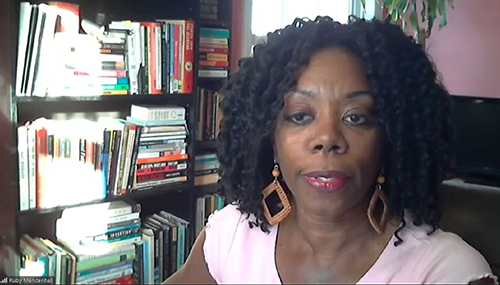
CIMED's Assistant Dean for Diversity and Democratization of Health Innovation, Ruby Mendenhall, shares with participants about today’s medical and health inequality.
December 30, 2020
Racism as a Health Crisis—this was the theme of the fall 2020, student-centered Health Make-a-Thon sponsored by the Carle Illinois College of Medicine (CIMED). Coming up with innovative ideas and solutions to address this year’s theme were eight teams of CIMED students, engineering students, health care professionals, and community members. The Saturday, December 5th virtual event was held via Zoom this year due to COVID-19, with a “Dolphin” Tank comprised of CIMED, university, industry, and community experts serving as judges to determine which teams would receive the 1st, 2nd, and 3rd place awards of $5000, $3000, and $2000, respectively.
Organized by the Health Maker Lab Executive Committee, comprised of Marty Burke, CIMED Associate Dean for Research; Ruby Mendenhall, CIMED Assistant Dean for Diversity and Democratization of Health Innovation; Irfan Ahmad, CIMED Assistant Dean for Research and Health Maker Lab Executive Director; and Lisa Goodpaster, CIMED Associate Director for Project Management, the Make-a-Thon ran from 8:00 am to 7:00 pm, beginning with introductions and Make-a-Thon instructions, followed by a presentation by Ruby Mendenhall. Information she shared with participants ranged from inequality in the U.S. historically, to today’s medical and health inequality, such as disparities in terms of COVID-19. Following the introductory material, the eight teams moved to breakout rooms to work all day on their ideas.
Teams were to address the following three questions:
- Which high-impact problem surrounding racism or areas related to racism as a health crisis (social justice, intersectionality, health disparities, wellness, food and shelter insecurities) do you want to tackle?
- How might an innovative solution you imagine impact or solve this problem?
- How will your solution impact the problem you identified?
The eight teams addressed a range of health-related ideas, several of which are briefly presented below.
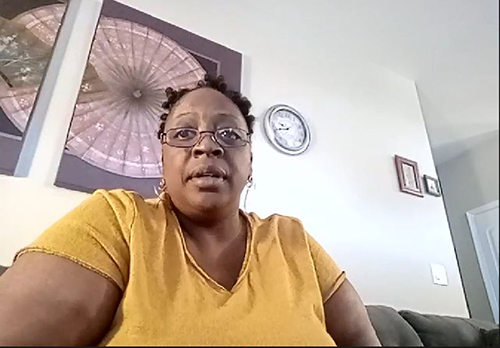
Team 1 member Val Adkinson shares a negative experience when dealing with a healthcare worker.
- For instance, after hearing from team member Valerie Adkinson about the issues she had encountered with an insensitive, less-than-helpful health-care worker, Team 1 proposed the Val App, which has an algorithm that tries to match the patient with an appropriate advocate.
- Team 2’s Inclusivity Score is calculated for a hospital, as well as its doctors and departments; Team 2 also devised an Inclusivity Dashboard.
- Team 4’s idea, Common Thread, was to help patients from marginalized communities feel more connected to their health care providers via ethnic-flavored clothing, such as uniforms, medical scrubs, etc.
- Team 5’s proposal, MedEx, was designed to use telehealth to drive down patient costs, improve access to health care providers, plus allow patients the freedom to choose the environment and time most comfortable for them.
- Team 7’s idea was an At-Risk Peripartum Screen, designed to screen pregnancy complications such as Preeclampsia and Pulmonary Embolism.
At 5:00 pm, the teams returned to the main room, where each had three minutes to present their pitch about their innovation to the Dolphin Tank, which, as in previous Make-a-Thons, is like a softer, gentler “Shark Tank” (from the tv show of the same name) comprised of scientists, engineers, scholars, healthcare providers, industry representatives, entrepreneurs, innovators, and citizen scientists from across the state of Illinois, who would then chose three winners.
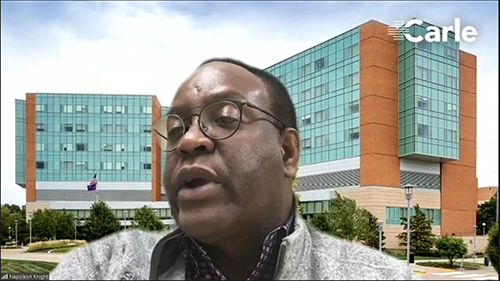
Dolphin Tank judget Napoleon Knight asks a team a question during the 3-minute Q&A session.
Dolphin tank members included Dolphin tank members included Stephen Boppart, CIMED Executive Associate Dean and Chief Diversity Officer; Olivia Coiado, CIMED Medical Education Facilitator; Gary Durack, Founder of the TEKMILL; Connie Frank, philanthropist and patient advocate; Alex Gorsuch, an engineering consultant and serial entrepreneur who serves as an Entrepreneur-in-Residence at EnterpriseWorks; Lynn Hasan Jones, MD, a radiologist, Board Member of Avicenna Community Health Center; Napoleon Knight, an MD, Medical Director South Region Emergency Departments, Carle Foundation Hospital; King Li, MD, Dean of the Carle Illinois College of Medicine; Laura Miller, Communications Coordinator, Health Alliance Medical Plans; Issam Moussa, MD., Medical Director, Carle Heart and Vascular Institute; Blair Rowitz, CIMED Associate Dean for Clinical Affairs and Clinical Assistant Professor as well as the Associate Chief Medical Officer for Surgical Services and the Associate Chief Academic Officer at Carle Foundation Hospital; Wendy Sanhai, Specialist Leader at Deloitte's Federal Strategy & Operations Team, Adjunct Associate Professor, Duke Medical School; Khan Siddiqui, MD, a radiologist, engineer, and serial entrepreneur interested in bringing healthcare to the masses through AI; Rachel Switzky, Director Siebel Center for Design; and Jed Taylor, Executive Director of Grainger College of Engineering’s Technology Entrepreneur Center and an Entrepreneur-in-Residence at the University’s EnterpriseWorks incubator.
During the team’s presentations, Dolphin Tank members had three minutes to ask questions, then vote on that particular team. After all eight teams had participated, the Dolphin Tank deliberated, then chose the top three teams, which were announced at the end.
Also, in a surprise appearance towards the end of the program, UI Chancellor Robert Jones congratulated the winning teams and other participants and lauded the efforts of the Carle Illinois College of Medicine Health Maker Lab in creating a health innovation ecosystem spanning campus and community.
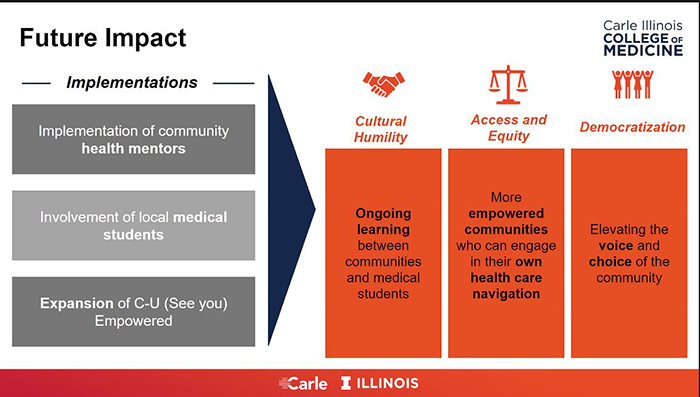
Team 8 slide explaining the idea behind C-U Empowered.
Following are the three winning teams who received awards, and a brief description of their ideas. For instance, third place was awarded to Team 8 for their idea: C-U Empowered, a broad-based health mentoring training program for community members, medical students, healthcare experts, and community mentors.
One Team 8 member, Karen Simms, was invited to participate in the Make-a-Thon based on her work with her not-for-profit, the Trauma & Resilience Initiative. “This topic—racism as a public health issue—is near and dear to my heart,” she explains, “because addressing the social determinants of health intersects perfectly with building trauma-informed communities.”
Indicating that the make-a-thon was “extremely valuable,” Simms calls it “interdisciplinary and designed to bring the campus and community together to solve big problems."

Team 8 member, Karen Simms, shares with participants via Zoom.
Simms shares about the Make-a-Thon experience: “I learned so much and was so privileged to serve on my team,” she acknowledges, “and I hope the students and other participants were able to learn from me too. On our team, our process was truly collaborative!”
Regarding the solutions presented at the Make-a-Thon, Simms says, “I thought many of the ideas were unique and interesting. However, addressing Racism in Health Care is a big issue, and I wish more time was spent helping people conceptualize this issue.”
Adding that the focus of many of the ideas were to address primarily health access issues she continues, “Addressing 'access' to care doesn't address the structural barriers: like affordability, the quality/nature of the experience with the provider and helping system, a provider not fully seeing or understanding the lived experience of those served, or practices that are not fully integrative, collaborative, or even empowering for the patient. But all in all, it was a wonderful experience!”
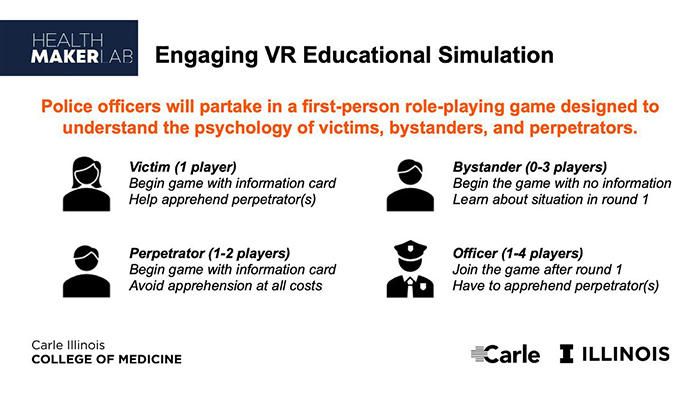
A slide presented by Team 6 about their solution, CrisisVR, in order to help police officers grasp the perspective of others via a role-playing game designed to help them understand the psychology of victims, bystanders, and perpetrators.
Taking second place was Team 6 with its CrisisVR, a virtual reality training program designed to improve police officers’ cultural sensitivity and psychosocial skills when dealing with others—especially those of other races and ethnic groups.
The first-place prize was awarded to Team 3 for ProteCKD, a prevention program targeting at-risk and marginalized communities to decrease instances of Chronic Kidney Disease (CKD) plus lower the health care burden. Statistics show that 17% of Caucasians compared to 40% of African Americans are unaware that they have Chronic Kidney Disease (CKD); plus, African Americans are 3.5 times more likely to progress to end-stage renal disease. This gap is caused by limited understanding of CKD, a low trust of health care systems, plus the financial burden. Thus, ProteCKD intends to focus on prescreening via a kidney function pre-screening kit, education about the disease, and to provide accessibility by serving as a bridge to community resources (see image at the end of the article). The pre-screening kit would include a low-cost home urine test strip and educational materials to empower people to make good choices and take charge of their own healthcare.
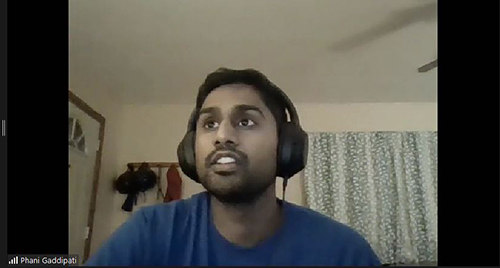
Team 3’s Phani Gaddipati shares about his team's winning idea, ProteCKD.
Sharing why he participated in the Make-a-Thon, Team 3’s Phani Gaddipati calls it “pretty unique, in that it involves people from the hospital, undergrads, and community members. So, I thought it would be a good opportunity to work with such a diverse group. I also think it’s a great way to explore some ideas that me and my classmates have had during clerkships.”
His team’s solution was a simple kit and plan to detect early signs of Chronic Kidney Disease (CKD) in high-risk communities, indicating that CKD disproportionately affects minorities.
“Our solution is low-cost and integrates into existing community networks for a wide reach in at-risk communities,” he explains.
Re the benefit of participating to him personally, he claims he experienced “rapid brainstorming and design with people from a variety of different backgrounds and an opportunity to apply my engineering and medical knowledge to tackle real problems.”
Story by Elizabeth Innes, Communications Specialist, I-STEM Education Initiative. Photos by Elizabeth Innes unless otherwise noted..
For more related stories, see: Carle Illinois, 2020
For an additional I-STEM articles about Carle Illinois College of Medicine, see:
- Health Make-a-Thon Encourages Local Citizens to Dream Up Ideas for Improving Health
- The (Future) Doctor is in the House: Meet an Illinoisan in the Inaugural Carle Illinois Medical Program
- Underrepresented Minority Undergraduate Students Gain Research, Clinical Experience Via the Carle Illinois College of Medicine’s New REACH RCEU
- Undergrad Brione Griffin Gets One Step Closer to Her Dream of Becoming a Doctor Via REACH RCEU

A member of Team 3 discusses their submission, ProteCKD.

How Team 5's MedEx solution works.













.jpg)
















